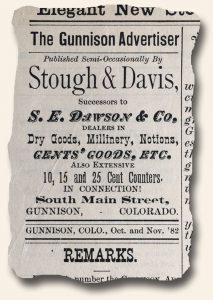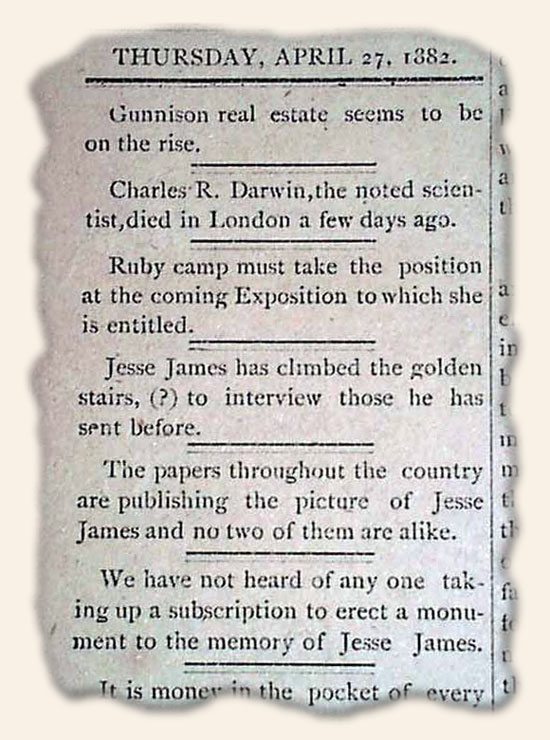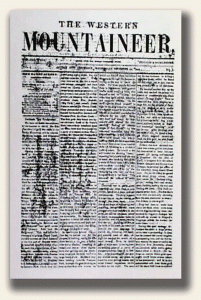Perhaps one of Gilligan’s ancestors… What does it mean?
November 28, 2016 by TimHughes · Leave a Comment
 An issue of “The Gunnison Advertiser” from Colorado, 1882, notes that it is: “Published Semi-Occasionally…”. Just what does this mean? If “occasionally” means it is not on any set schedule–printed at the whim of the publisher–how much more defining is “semi-occasionally”?
An issue of “The Gunnison Advertiser” from Colorado, 1882, notes that it is: “Published Semi-Occasionally…”. Just what does this mean? If “occasionally” means it is not on any set schedule–printed at the whim of the publisher–how much more defining is “semi-occasionally”?
Just curious. Any ideas?
When “white paper” was unavailable the presses kept running…
January 2, 2015 by TimHughes · Leave a Comment
We recently came across an interesting issue of “The Daily Rocky Mountain News” from Denver, dated Oct. 4, 1864. The uniqueness was not in the reporting; it was in the newspaper itself. Rather than printed on traditional newsprint stock, this issue is printed on pink-colored tissue paper. Fortunately, although very flimsy, it is not the least bit fragile.
 It was not unusual for print shops to run out of newsprint and to become inventive in finding ways to get out the day’s edition, particularly for newspapers in remote parts of the country as most paper mills were located in the Northeast. Think of the famous wallpaper issues from the Civil War. Some investigating came across the reason. One website on the history of the “Rocky Mountain News” noted that: “…When the Indian outbreak caused an embargo on traffic over the Western plains in 1864-5, he frequently ran out of white paper, and in such emergencies he printed the news on wrapping paper gathered from Denver stores…”. So this pink paper was wrapping paper. I wonder how long the need for “necessity paper” lasted. We also have two more issues with a similar date which are printed on yellow and green paper. In any case, very interesting curiosities for this fascinating hobby.
It was not unusual for print shops to run out of newsprint and to become inventive in finding ways to get out the day’s edition, particularly for newspapers in remote parts of the country as most paper mills were located in the Northeast. Think of the famous wallpaper issues from the Civil War. Some investigating came across the reason. One website on the history of the “Rocky Mountain News” noted that: “…When the Indian outbreak caused an embargo on traffic over the Western plains in 1864-5, he frequently ran out of white paper, and in such emergencies he printed the news on wrapping paper gathered from Denver stores…”. So this pink paper was wrapping paper. I wonder how long the need for “necessity paper” lasted. We also have two more issues with a similar date which are printed on yellow and green paper. In any case, very interesting curiosities for this fascinating hobby.
Interesting comments on Jesse James…
June 6, 2014 by TimHughes · Leave a Comment
The April 27, 1881 issue of the rare “Elk Mountain Pilot” from the ghost town of Irwin, Colorado, has 3 interesting and unusual tidbits concerning the recent death of the noted outlaw, Jesse James: “Jesse James has climbed the golden stairs, (?) to interview those he has sent before.” and: “The papers throughout the country are publishing the picture of Jesse James and no two of them are alike.” as well as: “We have not heard of any one taking up a subscription to erect a monument to the memory of Jesse James.” Yet another tidbit mentions the death of Charles Darwin – making these mentions an interesting tandem.
Colorado’s first newspapers…
November 16, 2009 by TimHughes · 1 Comment
 Credit is given to John Oswald’s “Printing In The Americas” for much of the following:
Credit is given to John Oswald’s “Printing In The Americas” for much of the following:
Colorado was first organized as the “Jefferson Territory” in October, 1859 and Congress renamed it Colorado Territory in February, 1861. It would become a state in 1876 hence it’s nickname “Centennial State”.
Colorado’s first printing was done in on April 23, 1859, on which date two newspapers were established in Denver, a town named after James W. Denver, the territorial governor of Kansas, and now occupying the site of two towns originally called Auraria and St. Charles. The “Rocky Mountain News” was started by William Byers, John Dailey & Thomas Gibson. Byers became the sole owner in 1870. The second newspaper, the “Cherry Creek Pioneer“, was started by John Merrick but only lasted for just a single issue. But shortly thereafter the “Rocky Mountain Gold Reporter & Mountain City Herald” was started August 6, 1859 at “Mountain City, Jefferson Territory”. A few months later the same printing press was used to launch the “Western Mountaineer” at Golden, Colorado.
The first daily newspaper in Colorado was the “Daily Herald and Rocky Mountain Advertiser” dating from May 1, 1860, and nearly four months later the “Rocky Mountain News” also became a daily publication.
There being no United States mail throughout Colorado at that time the newspapers were delivered by carriers mounted on burros to the various mining camps at 25 cents per copy, or $24 per year. One can imagine with such a lack of efficient distribution how small the print runs were and how few issues would survive to the 20th century.
Keep in mind that these early publication dates coincided with the Colorado “gold rush” which ran from 1859 to 1861 or so. It was typical that newspapers would spring up in areas when population would boom and land development was flourishing. Newspapers were quick to arise wherever the people would be, as was the case in California, Alaska and many other Western states.
Any of these early Colorado newspapers from 1859 or the early 1860’s are exceedingly scarce and would be choice issues for any collection.


